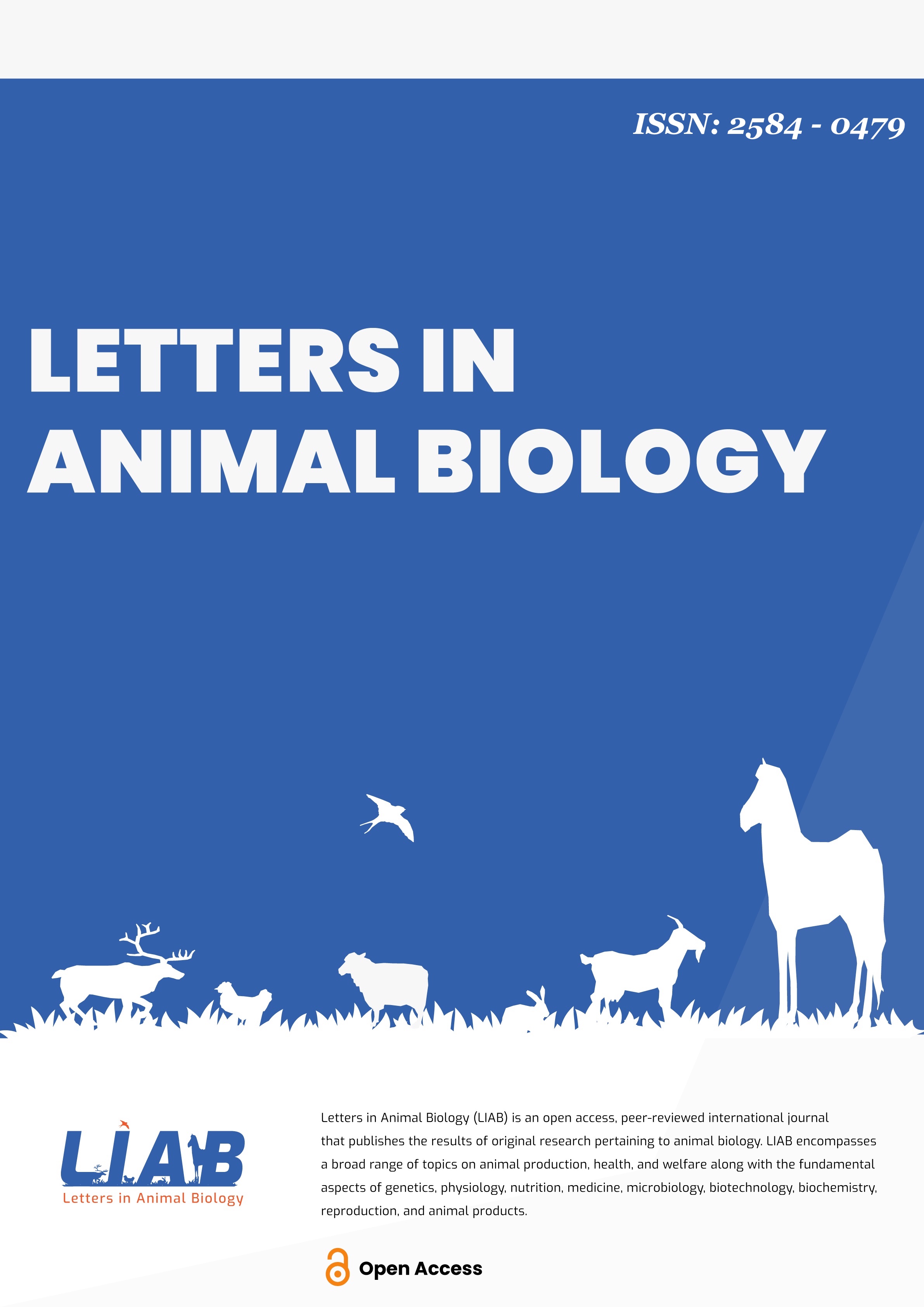Assessing probiotic attributes and molecular characterization of Weissella confusa from barbari goat faeces using 16S rRNA
Probiotic attributes and molecular characterization of Weissella confusa
DOI:
https://doi.org/10.62310/liab.v5i2.242Keywords:
Weissella confusa, Probiotics, 16S rRNA, Goat faeces, Lactic acid bacteria, Molecular identificationAbstract
The present study examined the probiotic potential and molecular characterization of Weissella confusa isolated from goat faeces using 16S rRNA gene sequencing. A total of 15 lactic acid bacterial isolates were obtained from 42 fresh faecal samples collected from healthy barbari goats. Based on morphological, biochemical, and molecular analyses, two isolates goat faecal-7 (GF-7) and goat faecal-8 (GF-8) (Genbank accession numbers: MZ314055.1 Weissella confusa India and MZ314055.2 Weissella confusa India) were identified as W. confusa with 99.2% similarity to reference sequences in GenBank. The isolates demonstrated significant probiotic attributes including acid tolerance (survival at pH 2.5), bile salt resistance (0.3% oxgall), adhesion to intestinal epithelial cells (34.2%), and antimicrobial activity against Escherichia coli ATCC 25922 and Staphylococcus aureus ATCC 25923. Antibiotic susceptibility testing revealed sensitivity to ampicillin, chloramphenicol, and tetracycline, indicating their safety for potential probiotic applications. The strains produced lactic acid at a concentration of 8.4 g/L and exhibited β-galactosidase activity. Phylogenetic analysis confirmed that the isolates belong to the Weissella genus. The results indicate that W. confusa MZ314055.1 and MZ314055.2 possess probiotic characteristics suitable for functional food development and animal health enhancement.
Metrics
References
Ahmed S, Singh S, Singh V, Roberts K D, Zaidi A, Rodriguez-Palacios A. (2022). The Weissella Genus: Clinically Treatable Bacteria with Antimicrobial/Probiotic Effects on Inflammation and Cancer. Microorganisms 10(2): 2427. https://doi.org/10.3390/microorganisms10122427
Andersson AF, Lindberg M, Jakobsson H, Backhed F, Nyren P, Engstrand L. (2008). Comparative analysis of human gut microbiota by barcoded pyrosequencing. PLoS One 3(7): e2836. https://doi.org/10.1371/journal.pone.0002836
Begley M, Gahan CG, Hill C. (2005). The interaction between bacteria and bile. FEMS Microbiology Reviews 29(4): 625-651. https://doi.org/10.1016/j.femsre.2004.09.003
Chen YS, Yanagida F, Hsu J S. (2006). Isolation and characterization of lactic acid bacteria from suan-tsai (fermented mustard), a traditional fermented food in Taiwan. Journal of Applied Microbiology 101(1): 125-130. https://doi.org/10.1111/j.1365-2672.2006.02900.x
Clinical and Laboratory Standards Institute. (2020). Performance standards for antimicrobial susceptibility testing, 30th ed CLSI supplement M100 Clinical and Laboratory Standards Institute, Wayne, PA. https://iacld.com/UpFiles/Documents/672a1c7c-d4ad-404e-b10e-97c19e21cdce.pdf
Danielsen M, Wind A. (2003). Susceptibility of Lactobacillus spp. to antimicrobial agents. International Journal of Food Microbiology 82(1): 1-11. https://doi.org/10.1016/s0168-1605(02)00254-4
Dunne C, O'Mahony L, Murphy L, Thornton G, Morrissey D, O'Halloran S, Feeney M, Flynn S, Fitzgerald G, Daly C, Kiely B, O’Sullian GC, Shanahan F, Collins JK. (2001). In vitro selection criteria for probiotic bacteria of human origin: correlation with in vivo findings. The American Journal of Clinical Nutrition 73(2): 386s-392s. https://doi.org/10.1093/ajcn/73.2.386s
FAO/WHO. (2006). Probiotics in food: Health and nutritional properties and guidelines for evaluation. Food and Agriculture Organization of the United Nations & World Health Organization Technical Report. https://openknowledge.fao.org/server/api/core/bitstreams/382476b3-4d54-4175-803f-2f26f3526256/content
Fusco V, Quero GM, Cho GS, Kabisch J, Meske D, Neve H, Bockelmann W, Franz CMAP. (2015). The genus Weissella: taxonomy, ecology and biotechnological potential. Frontiers in Microbiology 6: 155. https://doi.org/10.3389/fmicb.2015.00155
Hill C, Guarner F, Reid G, Gibson GR, Merenstein DJ, Pot B, Morelli L, Canani RB, Flint HJ, Salminen, Calder PC, Sanders ME. (2014). Expert consensus document: The International Scientific Association for Probiotics and Prebiotics consensus statement on the scope and appropriate use of the term probiotic. Nature Reviews: Gastroenterology & Hepatology 11(8): 506-514. https://doi.org/10.1038/nrgastro.2014.66
Janda JM, Abbott SL. (2007). 16S rRNA gene sequencing for bacterial identification in the diagnostic laboratory: pluses, perils, and pitfalls. Journal of Clinical Microbiology 45(9): 2761-2764. https://doi.org/10.1128/JCM.01228-07
Salvetti E, Torriani S, Felis GE. (2012). The genus Lactobacillus: a taxonomic update. Probiotics and Antimicrobial Proteins 4(4): 217-226. https://doi.org/10.1007/s12602-012-9117-8
Savaiano DA, Hutkins RW. (2021). Yogurt, cultured fermented milk, and health: a systematic review. Nutrition Reviews 79(5): 599-614. https://doi.org/10.1093/nutrit/nuaa013
Silvaa Diego Romário, Janaína de Cássia Orlandi Sardib, Nayla de Souza Pitanguic, Sindy Magri Roquee, Andréa Cristina Barbosa da Silvaf, Pedro Luiz Rosalena. (2020). Probiotics as an alternative antimicrobial therapy: Current reality and future directions Journal of Functional Foods (73): 104080. https://doi.org/10.1016/j.jff.2020.104080
Stackebrandt E, Ebers J. (2006). Taxonomic parameters revisited: tarnished gold standards. Microbiology Today 33(4): 152-155.
Tuomola E, Crittenden R, Playne M, Isolauri E, Salminen S. (2001). Quality assurance criteria for probiotic bacteria. The American Journal of Clinical Nutrition 73(2): 393s-398s. https://doi.org/10.1093/ajcn/73.2.393s
Downloads
Published
How to Cite
Issue
Section
License
Copyright (c) 2025 Prashant Pandey, Ajit Kumar, Harshit Verma; Debashis Roy; Mrinal Srivastava, Malyaj R. Prajapati, Shriya Rawat, Atul Gupta, Nishant Sharma

This work is licensed under a Creative Commons Attribution 4.0 International License.
Accepted 2025-09-29
Published 2025-10-07









